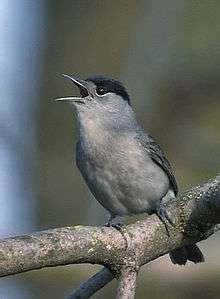Sylviidae
| Sylviidae | |
|---|---|
 | |
| Eurasian blackcap (Sylvia atricapilla) | |
| Scientific classification | |
| Kingdom: | Animalia |
| Phylum: | Chordata |
| Class: | Aves |
| Order: | Passeriformes |
| Superfamily: | Sylvioidea |
| Family: | Sylviidae Leach, 1820 |
| Genera | |
|
See text | |
Sylviidae is a family of passerine birds that includes the typical warblers, parrotbills, the wrentit, and a number of babblers formerly placed within the Old World babbler family. They are found in Eurasia, Africa, and the west coast of North America.
Taxonomy and systematics
The scientific name Sylviidae was coined by the English zoologist William Elford Leach in a guide to the contents of the British Museum published in 1820.[1][2] Formerly, the family was part of an assemblage known as the Old World warblers and was a wastebin taxon with over 400 species of bird in over 70 genera.[3] Advances in classification, particularly helped with molecular data, have led to the splitting out of several new families from within this group. There is now evidence that these Sylvia "warblers" are more closely related to the Old World babblers than the warblers and thus these birds are better referred to as Sylvia babblers, or just sylvids.[4]
A molecular phylogenetic study using mitochondrial DNA sequence data published in 2011 found that the species in the genus Sylvia formed two distinct clades.[5] Based on these results, the ornithologists Edward Dickinson and Leslie Christidis in the fourth edition of Howard and Moore Complete Checklist of the Birds of the World, chose to split the genus and moved most of the species into a resurrected genus Curruca retaining only the Eurasian blackcap and the garden warbler in Sylvia. In an additional change they moved the African hill babbler and Dohrn's thrush-babbler into Sylvia.[6] The split was not made by the British Ornithologists' Union on the grounds that "a split into two genera would unnecessarily destabilize nomenclature and results in only a minor increase in phylogenetic information content."[7]
List of genera
The family includes 70 species divided into 20 genera:[8]
- Myzornis – monotypic, fire-tailed myzornis[9]
- Parophasma – monotypic, Abyssinian catbird
- Pseudoalcippe – (2 species). Formerly in Illadopsis (Timaliidae)
- Horizorhinus – monotypic, Dohrn's thrush-babbler. Formerly in Timaliidae
- Lioptilus – monotypic, bush blackcap. Formerly in Timaliidae
- Sylvia – typical warblers (28 species)
- Lioparus – monotypic, golden-breasted fulvetta. Formerly in Alcippe (Timaliidae)
- Moupinia - monotypic, rufous-tailed babbler. Formerly in Chrysomma
- Fulvetta – typical fulvettas (8 species). Formerly in Alcippe (Timaliidae)
- Chrysomma – (2 species). Formerly in Timaliidae
- Rhopophilus – (2 species). Formerly in Cisticolidae
- Chamaea – monotypic, wrentit
- Conostoma – monotypic, great parrotbill. Formerly in Paradoxornithidae; tentatively placed here
- Cholornis – (2 species). Formerly in Paradoxornithidae;
- Sinosuthora – (6 species). Formerly in Paradoxornithidae;
- Suthora – (3 species). Formerly in Paradoxornithidae;
- Neosuthora – monotypic, short-tailed parrotbill. Formerly in Paradoxornithidae;
- Chleuasicus – monotypic, pale-billed parrotbill. Formerly in Paradoxornithidae;
- Psittiparus – (4 species). Formerly in Paradoxornithidae;
- Paradoxornis – (3 species). Formerly in Paradoxornithidae
Description
Sylviids are small to medium-sized passerine birds. The bill is generally thin and pointed with bristles at the base. Sylviids have a slender shape and an inconspicuous and mostly plain plumage. The wings have ten primaries, which are rounded and short in non-migratory species.[3]
Distribution and habitat
Most species occur in Asia, and to a lesser extent in Africa. A few range into Europe and one species, the wrentit, occurs on the west coast of North America.
References
| Wikimedia Commons has media related to Sylviidae. |
- ↑ Leach, William Elford (1820). "Eleventh Room". Synopsis of the Contents of the British Museum (17th ed.). London: British Museum. pp. 65–70. OCLC 6213801. The name of the author is not specified in the document. A scan of the 18th edition published in 1821 is available from Google. The page numbers are identical.
- ↑ Bock, Walter J. (1994). History and nomenclature of avian family-group names. Bulletin of the American Museum of Natural History Issue 222. pp. 152, 245.
- 1 2 Bairlein, F.; Bonan, A. "Old World Warblers (Sylviidae)". In del Hoyo, J.; Elliott, A.; Sargatal, J.; Christie, D.A.; de Juana, E. Handbook of the Birds of the World Alive. Lynx Edicions. Retrieved 15 December 2016. (Subscription required (help)).
- ↑ "SYLVIDS Sylviidae". Bird Families of the World. Retrieved 6 March 2017.
- ↑ Voelker, Gary; Light, Jessica E. (2011). "Palaeoclimatic events, dispersal and migratory losses along the Afro-European axis as drivers of biogeographic distribution in Sylvia warblers". BMC Evolutionary Biology. 11 (163). doi:10.1186/1471-2148-11-163.
- ↑ Dickinson, E.C.; Christidis, L., eds. (2014). The Howard & Moore Complete Checklist of the Birds of the World, Volume 2: Passerines (4th ed.). Eastbourne, UK: Aves Press. pp. 509–512. ISBN 978-0-9568611-2-2.
- ↑ Sangster, G.; et al. (2016). "Taxonomic recommendations for Western Palearctic birds: 11th report". Ibis. 158 (1): 206–212. doi:10.1111/ibi.12322.
- ↑ Gill, Frank; Donsker, David, eds. (2017). "Sylviid babblers, parrotbills & white-eyes". World Bird List Version 7.3. International Ornithologists' Union. Retrieved 7 September 2017.
- ↑ Gelang, Magnus; Alice Cibois; Eric Pasquet; Urban Olsson; Per Alström; Per G. P Ericson (2009). "Phylogeny of babblers (Aves, Passeriformes): major lineages, family limits and classification". Zoologica Scripta. 38 (3): 225–236. doi:10.1111/j.1463-6409.2008.00374.x.